North Sea Solitude: A Winter Walk Across Norderney
Our company suddenly changed its vacation policy: unused days from the previous year now had to be taken by the end of January. So I had no choice but to take time off. Naturally, I went to the sea. The North Sea, to be precise. Luckily, it’s only a three-hour drive from where I live. The North Sea in January — it already sounds like a ballad of adventure and wandering.
From the densely populated Rhine-Ruhr area, the A31 autobahn heads north—almost dead straight, across a pancake-flat plain. Out the window, the only thing that changes are the names of towns on the exit signs and the license plates on the trucks I occasionally overtake. Wind turbines to the left, wind turbines to the right. This stretch of road definitely deserves the proud title of “Germany’s most boring autobahn.”
After getting off the highway, the road winds through a series of low-rise towns with forgettable names, before ending at a port and a comically large parking lot—which, at this time of year, is almost empty. Next up: the ferry.
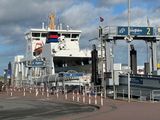
The sea here is a bit… strange. It’s like it hasn’t quite decided whether it wants to be a proper sea. Shallow like a puddle, murky, with endlessly gradual shores. About 15 kilometers out, this indecisiveness turns into a scattered chain of sandy islands barely rising above sea level. These are the East Frisian Islands. Administratively, they belong to the German state of Lower Saxony. The locals are called Frisians and speak the Frisian language.
My target for the day was the island of Norderney, and the small town of the same name.
The ferry is massive, moving smoothly along a buoy-marked channel like it’s on a road. No rocking. The water is muddy, and you can’t see the bottom, but you can feel how shallow it is. The upper deck is almost empty—thanks to a bracing sea breeze that confidently sneaks into any unzipped jacket.
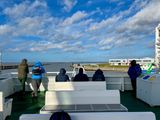
Nothing describes the local wind better than these trees. And no, the horizon isn’t tilted—this was taken straight.
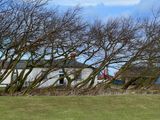
Geographically, Germany didn’t get any sun-kissed shores with olive trees and turquoise waters. So it had to build a resort wherever it could—on the North Sea.
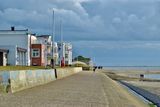
In summer, this place is packed with tourists. There are lines for the restaurants, and hotel rooms need to be booked six months in advance. On the beaches, you’ll see those charming vintage-looking wicker beach chairs—Strandkörbe—where visitors hide from the wind and breathe the “healing” air. The water? Probably still uninviting, even in August.
Now, in January, it’s nearly deserted. Just a few sad shadows roaming the streets—souls forced into vacation during the off-season. Almost everything is closed: hotels, restaurants, shops. “On holiday until mid-February,” say the signs. Or “until end of February,” or “until end of March.”
Incidentally, I was the only guest in my hotel. Someone else might be arriving Thursday.
And yet—bike rentals are open. For some reason.
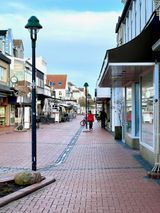
One thing that’s free, available year-round, and almost weatherproof: the beach. There are 14 kilometers of it, stretching across the entire northern coast of the island. So that’s what I went to explore.
A nicely built promenade, complete with benches and walking paths, leads to the island’s highest dune. At its peak sits an old anchor, carefully painted, and an ornate mast poking out of the sand.
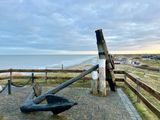
This is where the town ends. Ahead: sand. Smooth, grassless, shell-speckled sand—that’s the beach. The little grassy sand mounds? Those are dunes. It’s all very simple.
Walking the beach turned out to be quite pleasant. The sand is so compact it barely yields under my not-insignificant weight. Waves rumble on the left, gulls screech and dive, dunes rise on the right. You’re not allowed to walk into the dunes, except on designated paths—it’s a protected nature reserve. People walk up and down the beach: solo, in pairs, in groups, with or without dogs, Nordic walking poles optional. Naturally, the farther from town you go, the fewer people you see.

At some point, I came across a seal lying on the sand. He was about 30 meters from the waterline, chilling on his side with his back flippers stretched out. When he noticed me, he lazily raised his head but didn’t flee. Gave me a slow, indifferent look. I asked how he was doing, but I guess he was a Frisian seal—didn’t understand and didn’t respond.
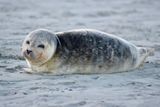
There were fewer and fewer people, and eventually, I passed a bespectacled guy with a backpack. After that—nobody. Not a soul, as far as the eye could see. Just me, the sea, the birds, and a giant, empty beach. A pretty surreal feeling.
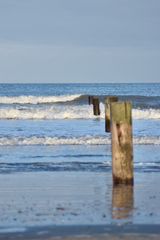
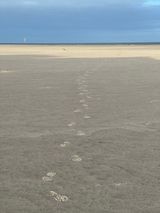
Almost the entire eastern side of the island is a national park. You’re asked to keep quiet and not disturb the animals. The landscape is fairly monotonous, but not boring. I saw more seals along the way, but these were much more skittish—bolting for the water as soon as they spotted me, even though I wasn’t trying to approach.
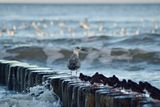
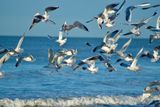
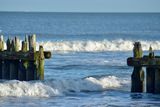
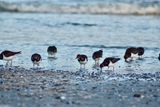
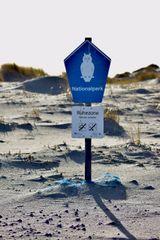
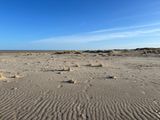
Eventually, I reached the easternmost tip of the island. There lies the rusting skeleton of a long-wrecked boat—now a local landmark. Beyond it: just water. Across a narrow channel, you can clearly see the dunes and cottages of the neighboring island.
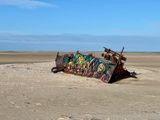
For the way back, I decided to mix things up and take the southern route. That turned out to be… not the best idea. This area is made up of tidal meadows—flooded by the sea. The path twists endlessly between sketchy-looking puddles coated in greasy, oily film. Mud squelches underfoot. The sun disappeared. You have to jump over narrow streams that don’t look appealing to wade through. Scattered around are the half-decayed bodies of dead rabbits in various states of decomposition.
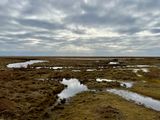
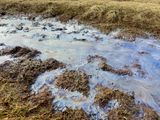
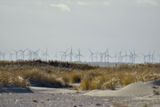
Honestly, it felt like walking through Death Stranding—minus the rain and supernatural weirdness. Not exactly a fun detour.
Hard to get lost, though. The route is marked by wooden posts with white-green stripes on top. You walk from one post to the next. Rinse and repeat. On the map it’s maybe five or six kilometers in a straight line, but the winding path makes it feel a lot longer. And the terrain… let’s just say it’s not paved.
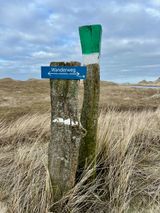
Fortunately, the misery ends eventually, and you hit a paved path. Still eight kilometers back to town.
About halfway, there’s a lighthouse. Built 150 years ago, still in use. At night, it shines in all directions with a powerful beam—you can see it from the town. There’s also a small airstrip nearby for light aircraft.
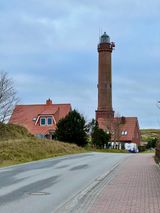
There are a few horses grazing here and there, occasional groves of trees, and some deserted trailer parks—empty in winter, of course.
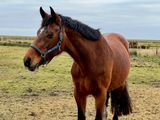
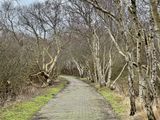
Then the path leads back to houses, more and more of them, and finally—you’re back in town. And at the hotel.

I ended up walking 35 kilometers in total. Left at 9 a.m., got back around 5 p.m. All in all, a great day—except for the swampy stretch on the way back. If you’re also drawn to lonely places, I’d recommend walking up the beach to the lighthouse—it’s visible from afar—and heading back through the dunes. Or just stick to the beach. It’s worth it.
The next day, the weather turned. A wind blew in from the sea, bringing fog and annoying drizzle. My trip was over, and I headed home in reverse: ferry, then autobahn.
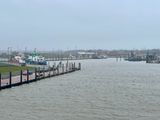
All in all? It was great, despite being January. I got lucky with the weather—sunny and fairly warm. I liked the town, loved the beach, hated the marsh.
It’s definitely a place worth visiting if you want to unplug from the endless stream of stuff happening. Best leave your phone and gadgets at home and just be bored for a week—listening to the waves and the cries of the gulls.